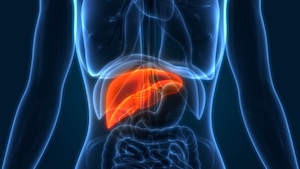Liver Disease in Diabetes – An Overlooked Complication
By Matthew Garza
 NAFLD and NASH are two types of liver disease that affect many people with diabetes, however, they are only just now getting the attention they deserve and unfortunately there are only limited treatment options currently available. Hear what experts have to say about the prevention and management of these conditions.
NAFLD and NASH are two types of liver disease that affect many people with diabetes, however, they are only just now getting the attention they deserve and unfortunately there are only limited treatment options currently available. Hear what experts have to say about the prevention and management of these conditions.
The liver is a vital organ in the body that filters the blood, produces essential nutrients for the body, and breaks down medications. However, the liver can become damaged from things like alcohol consumption, excess weight (especially excess abdominal fat), and excess fat delivered to the liver from fat cells. This often occurs in people with abnormal blood lipid levels (typically low HDL-cholesterol, and high triglycerides) and high blood pressure with or without diabetes.
Nonalcoholic fatty liver disease (NAFLD) occurs when fat builds up in the liver. An estimated 60% of people with type 2 diabetes have this chronic liver disease. When this condition progresses, it can turn into nonalcoholic steatohepatitis (NASH).
NASH is when cells in the liver become inflamed and the cells develop fibrosis, or the thickening and scarring of the tissue. This includes an excessive buildup of proteins like collagen which occurs in many chronic liver diseases.
When NASH progresses further, this advanced liver fibrosis can result in cirrhosis (permanent scarring and liver damage), liver failure, and portal hypertension (high pressure in the portal veins in the liver) and often requires liver transplantation.
These conditions occur disproportionately in people with diabetes. Dr. Kenneth Cusi, chief of the Division of Endocrinology, Diabetes & Metabolism at the University of Florida, explained in a presentation at the ADA’s 82nd Scientific Sessions that in populations with higher rates of diabetes, there are also higher rates of NAFLD and NASH.
Only recently has the ADA issued guidelines for the diagnosis, management, and treatment of NAFLD and NASH. Cusi stressed that we should view NASH as part of the “triangle of care” for people with diabetes, along with cardiovascular (heart) disease and nephropathy (kidney disease).
Getting screened
Early detection is key to preventing or reversing the progression of liver damage. However, this is only possible with screening techniques which are not commonly used. Cusi explained that one of these screening tests for NAFLD and NASH – called FIB-4 – can help identify those who are at a high risk for liver fibrosis.
FIB-4 is a score that is calculated from your age, liver enzyme test results (AST and ALT), and blood platelet level. When you are at your next healthcare appointment, ask your provider if you can receive this screening test. NAFLD and NASH often do not have any noticeable signs or symptoms, so getting screened is crucial even if you don’t think anything is wrong.
Treating NAFLD and NASH
If your screening determines that you have NAFLD or NASH (or that you are at risk for these conditions) – your healthcare provider will start by recommending lifestyle interventions including, because unfortunately, there are no specific medications yet approved for diabetes-related liver disease:
-
Weight loss and management
-
Healthy eating habits
-
Reducing alcohol intake
-
Increased physical activity
Cusi explained these interventions particularly target weight loss which may help these liver diseases. Losing weight can reduce the buildup of fat in the liver and reverse damage to this organ.
Although there are no specific medications approved for treating NASH or NAFLD in people with diabetes, Cusi, as well as Dr. Fernando Bril, fellow – Endocrinology & Diabetes, Graduate Medical Education-Hospital, University of Alabama at Birmingham, and Dr. Mohammad Shafi Kuchay, consultant endocrinologist, Medanta The Medicity Hospital, described how pioglitazone, GLP-1 receptor agonists, and SGLT-2 inhibitors may be emerging options for people with diabetes and NAFLD or NASH. If you are diagnosed with NAFLD or NASH, ask your healthcare provider if any of these medications may be options for you.
What does the future of NAFLD and NASH treatment look like?
Many clinical trials are underway, trying to identify potential drugs that could be used to treat NAFLD and NASH in people with diabetes.
In a fascinating presentation on the first day of the ADA conference, Dr. Elizabeth Speliotes, associate professor at the department of Internal Medicine at the University of Michigan, and Dr. Marijana Vujkovic, research assistant professor of medicine at the University of Pennsylvania, shared how researchers are looking into the specific genes associated with a person’s risk for NAFLD and NASH. This technique may one day be able to help pinpoint the drugs that could best treat these conditions in specific populations, or identify those most at risk for these conditions.
For more information on NAFLD and NASH, read, “Maintain the Health of Your Liver – Latest ADA Standards of Care.”








